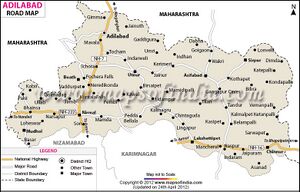Pareshvara
| Author:Laxman Burdak, IFS (R) |

Pareshvara (परेश्वर) is a prehistoric archaeological site in Adilabad district in Telangana.
Origin
Variants
- Pareshvara (परेश्वर), जिला आदिलाबाद, तेलंगाना, (AS, p.533)
- Pareshwar (परेश्वर)
History
At Pangri and Pareshwar there are prehistoric sites where neolithic implements such as flakes, cores and similar objects are in a fair state of preservation. An Indo-Aryan temple dating from the 14th and 16th centuries is a prominent feature at Wakdi. [1]
It is a matter of research if Pareshvara, prehistoric archaeological site in Adilabad district in Telangana, has any connection with Pareshwar or Padishkhwārgar of Iran.
Pareshwar or Padishkhwargar
Pareshwar or Padishkhwārgar was a Sasanian province in Late Antiquity, which almost corresponded to the present-day provinces of Mazandaran and Gilan province of Iran. The province bordered Adurbadagan and Balasagan in the west, Gurgan in the east, and Spahan in south. The main cities of the province were Amol and Rasht. The province functioned as some kind of vassal kingdom, being mostly ruled by princes from different royal families, who bore the title of Padashwargarshah ("Shah of Padishkhwargar").[2]
Name: The name "Padishkhwargar" is the Bundahishn variation of its name. On Shapur I's inscription at the Ka'ba-ye Zartosht the province is called Parishkhwargar, whilst Islamic sources refer the region as Tabaristan,[3] which derives from Middle Persian Tapurstān.
History: Silver gilt dish from Padishkhwargar, 7th–8th centuries. A tradition initiated under the Sasanian Empire and continued after the Arab invasions. "Anuzhad" inscription in Pahlavi script, next to the reclining figure. British Museum.
During the rise of the Sasanian dynasty, Padishkhwargar was ruled by a certain Gushnasp, who aided his suzerain the Parthian ruler Artabanus V (r. 213–224) in his struggle with the first Sasanian king (shah) Ardashir I (r. 224–242) over the control of Iran. Artabanus V was eventually defeated and killed, and Gushnasp was made a Sasanian vassal.[4] Gilan, which was never fully incorporated into the Sasanian Empire, still posed a problem for the Sasanians, as Ardashir's son and successor Shapur I (r. 240–270) had to make an expedition into the region in 242/3.[5] The dynasty of Gushnasp continued to rule Padishkhwargar until c. 520, when the Sasanian prince Kawus was made the new ruler of the province. After returning from an expedition in Zabulistan, Kawus rebelled in c. 532 against his recently crowned brother Khosrow I (r. 531–579), claiming himself as the rightful ruler of the empire due to being the elder brother.[6] He was defeated and executed the following year. In the 550s, Karin, a member of the House of Karen, received land to the south of Amol by Khosrow I, thus starting the Qarinvand dynasty.
परेश्वर
विजयेन्द्र कुमार माथुर[7] ने लेख किया है ...परेश्वर, जिला आदिलाबाद, तेलंगाना, (p.533): इस स्थान से नवपाषाण कालीन अवशेष, पत्थर के उपकरण आदि प्राप्त हुए हैं जिससे इस स्थान की प्रागैतिहासिकता सिद्ध होती है.
External links
References
- ↑ History And Legend In Hyderabad, Department of Information and Public Relations, 1953, p.4
- ↑ https://en.wikipedia.org/wiki/Padishkhwargar
- ↑ Brunner, Christopher (1983). "Geographical and Administrative divisions: Settlements and Economy". The Cambridge History of Iran: The Seleucid, Parthian, and Sasanian periods (2). Cambridge: Cambridge University Press. pp. 747–778. ISBN 978-0-521-24693-4.
- ↑ Madelung, Wilferd; Felix, Wolfgang (1995). "DEYLAMITES". Encyclopaedia Iranica, Vol. BII, Fasc. 4. pp. 342–347.
- ↑ Frye, Richard N. (1983). "The political history of Iran under the Sasanians". The Cambridge History of Iran: The Seleucid, Parthian, and Sasanian periods (1). Cambridge: Cambridge University Press. pp. 116–181. ISBN 978-0-521-24693-4.
- ↑ Pourshariati, Parvaneh (2008). Decline and Fall of the Sasanian Empire: The Sasanian-Parthian Confederacy and the Arab Conquest of Iran. London and New York: I.B. Tauris. ISBN 978-1-84511-645-3.
- ↑ Aitihasik Sthanavali by Vijayendra Kumar Mathur, p.533

